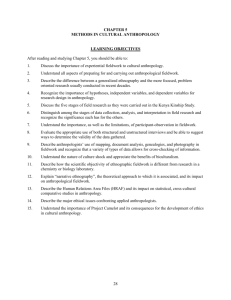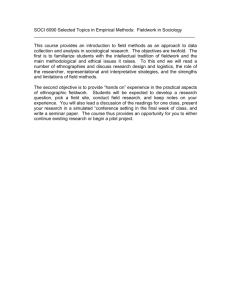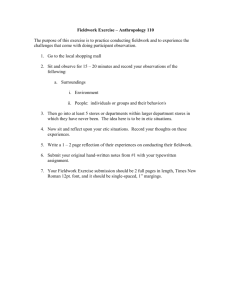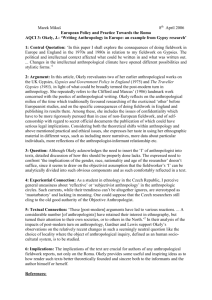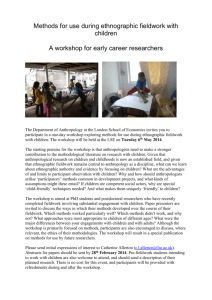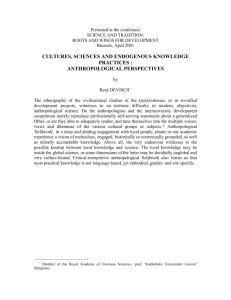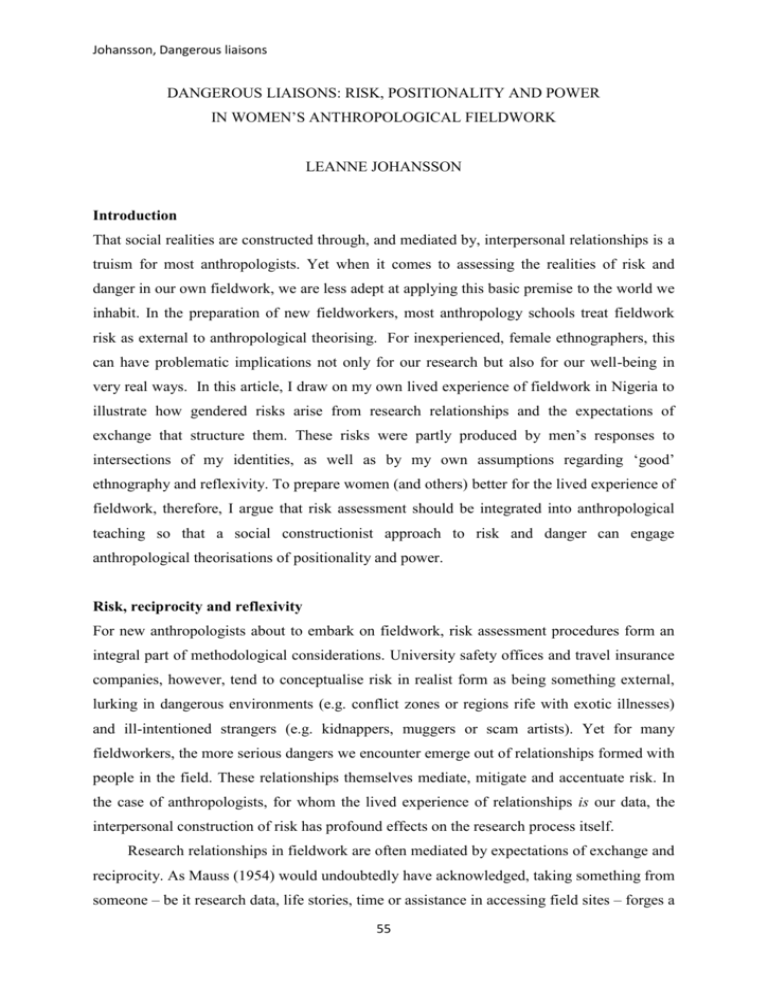
Johansson, Dangerous liaisons
DANGEROUS LIAISONS: RISK, POSITIONALITY AND POWER
IN WOMEN’S ANTHROPOLOGICAL FIELDWORK
LEANNE JOHANSSON
Introduction
That social realities are constructed through, and mediated by, interpersonal relationships is a
truism for most anthropologists. Yet when it comes to assessing the realities of risk and
danger in our own fieldwork, we are less adept at applying this basic premise to the world we
inhabit. In the preparation of new fieldworkers, most anthropology schools treat fieldwork
risk as external to anthropological theorising. For inexperienced, female ethnographers, this
can have problematic implications not only for our research but also for our well-being in
very real ways. In this article, I draw on my own lived experience of fieldwork in Nigeria to
illustrate how gendered risks arise from research relationships and the expectations of
exchange that structure them. These risks were partly produced by men’s responses to
intersections of my identities, as well as by my own assumptions regarding ‘good’
ethnography and reflexivity. To prepare women (and others) better for the lived experience of
fieldwork, therefore, I argue that risk assessment should be integrated into anthropological
teaching so that a social constructionist approach to risk and danger can engage
anthropological theorisations of positionality and power.
Risk, reciprocity and reflexivity
For new anthropologists about to embark on fieldwork, risk assessment procedures form an
integral part of methodological considerations. University safety offices and travel insurance
companies, however, tend to conceptualise risk in realist form as being something external,
lurking in dangerous environments (e.g. conflict zones or regions rife with exotic illnesses)
and ill-intentioned strangers (e.g. kidnappers, muggers or scam artists). Yet for many
fieldworkers, the more serious dangers we encounter emerge out of relationships formed with
people in the field. These relationships themselves mediate, mitigate and accentuate risk. In
the case of anthropologists, for whom the lived experience of relationships is our data, the
interpersonal construction of risk has profound effects on the research process itself.
Research relationships in fieldwork are often mediated by expectations of exchange and
reciprocity. As Mauss (1954) would undoubtedly have acknowledged, taking something from
someone – be it research data, life stories, time or assistance in accessing field sites – forges a
55
Johansson, Dangerous liaisons
relationship structured by debt, and some form of reciprocity is expected. The actors involved
may well have differing ideas about the size of the debt and the norms of reciprocity
surrounding it, making these expectations of exchange murky terrain to navigate for
inexperienced fieldworkers.
Navigating this politics of exchange and reciprocity involves acknowledging the
potentially exploitative nature of ethnographic research and the power dynamics involved in
research relationships. Since the reflexive turn in anthropology, promoted by the ‘new critics’
in the 1980s (e.g. Clifford and Marcus, 1986), such acknowledgement has become
mainstream in the discipline. Today any ‘good anthropologist’ is acutely aware of the
inequalities that structure research relationships, and he or she attempts, wherever possible, to
level the playing field. We actively strive to forge more egalitarian relationships by
attempting to minimise our own authoritative voices and creating space for the voices of
those we study. Part of this involves responding to and fulfilling expectations of reciprocity
and ‘giving back’ where we are able – hence the debates regarding activist and applied
anthropology (Farmer 2013, Scheper-Hughes 1995, Stanford and Angel-Ajani 2006).
It is in this critically self-aware anthropology that I have been schooled. I began
studying anthropology as an undergraduate student at the University of Cape Town in South
Africa in 2004, almost twenty years after Writing Culture was published (Clifford and
Marcus 1986). I am thus one in a generation of anthropologists for whom self-critique and
reflexivity have always been a part of the discipline as we know it. Long before I set out on
my own fieldwork experience, I was thus well equipped with ideas of the ‘good
anthropologist’, sensitive to the exploitative potential of anthropological fieldwork and to my
own empowered position as a researcher.
When I finally did embark on long-term fieldwork for my DPhil in Anthropology,
however, my experience proved to be somewhat less than empowering. Below, I outline two
examples of research relationships I encountered in order to demonstrate how the
expectations of exchange that structure such relationships, when combined with the sort of
self-critique that characterises contemporary anthropology, construct risky and dangerous
spaces for inexperienced fieldworkers. In my own fieldwork experience, such spaces were
gendered ones where sexual harassment and violence constituted the dominant danger.
Gate-keeper and informant relationships in fieldwork
From 2012 to 2013, in pursuit of my DPhil in Anthropology, I conducted thirteen months of
ethnographic fieldwork on the borderland between Nigeria and Cameroon. In order to
56
Johansson, Dangerous liaisons
examine the politics of place-making and cross-border mobility, I located myself in the
Bakassi peninsula, having gained some experience of the region in 2008 from working
nearby as a consultant. This peninsula has been the site of oil conflict since the 1970s, with
both countries claiming ownership of the territory. However, following the intervention of the
International Court of Justice (ICJ), Cameroon was granted sovereignty in 2002, despite the
fact that borderland inhabitants identify strongly as Efik Nigerians. When I started my
fieldwork, the deadline for Nigeria to appeal against the ICJ verdict was fast approaching,
and sensitivities were increasing, as was general insecurity around the peninsula.
According to the British Foreign Office, therefore, my field site was classified as a ‘nogo’ zone. As such, I had to demonstrate to the university that I had considered and prepared
for all possible risks by participating in several pre-fieldwork safety workshops and writing a
detailed risk assessment. Kidnappings, protest unrest, shootings, muggings and other
stranger-dangers were all potentialities I was prepared to encounter. What I was less prepared
for, however, was the manner in which the dangers of this external environment shaped, and
were shaped by, interpersonal relationships and day-to-day negotiations of them.
Gate-keeper relationships were the most obviously affected. Conducting fieldwork in a
high-risk environment accentuated the role of gate-keepers, granting them additional leverage
in political plays of reciprocity. In order to gain access to my field site and gather data
unhindered, I had first to secure permission from the administrative authorities and military
personnel, all of whom were men. In Nigeria, where the patrimonial state filters right down
into intimate client-patron relations, these ‘Big Men’ were not about to offer their assistance
without expecting something in return. Since I evidently had little to give in terms of power
and wealth, what they demanded was sexual. For example, one senior administrative official,
the man who granted me access to my field site, once invited me to a meeting in a distant city
(over two days journey from my actual field site), which turned out to be no ‘meeting’ at all.
He had booked a hotel room for the two of us for the weekend and had simply expected,
without any doubts, that I would spend the nights with him in gratitude for the role he had
played in my research. I managed to wriggle out of this uncomfortable situation by playing
extremely ‘dumb’, talking excessively about my fiancé and feigning another appointment in
the city.
One month after this incident, I refused the sexual advances of a high-ranking military
man who, unused to being denied, became angry and, as pay-back, insisted that I have
twenty-four hour military protection due to the instability of the region. His insistence was
unnecessary since my actual field site itself was relatively safe. Undertaking ethnographic
57
Johansson, Dangerous liaisons
research with armed bodyguards, however, is less than ideal, and the only way to rid myself
of them was to appeal to the military man’s superior, who was none other than the senior
administrative official who had booked the hotel room the previous month. This official was
happy to intervene on my behalf, but then I had to negotiate repeated declarations of love and
invitations to spend the night with him for the rest of my year in Bakassi.
Succumbing to the sexual advances of gate-keeper ‘Big Men’ was never an option for
me. At the same time, however, outright rejections of them – like the one I attempted with the
military man – had consequences for my research itself. As such, I spent the year ducking and
diving sexual encounters, massaging bruised egos and trying to keep in the good books of
powerful men whose expectations of exchange I was not willing to fulfil.
However, it was the gender dynamics embedded in my everyday interactions with male
informants that turned out to be even more exhausting and risky. My research method of indepth, life-history interviews and participant observation meant meeting the same people
regularly, talking about their lives, ‘hanging out’ and forming relationships. As a researcher, I
had ulterior motives which went beyond a need for mere friendship and intimacy – I wanted
their lives and stories as data for a thesis that would benefit my own career as an academic.
Schooled in post-1980s reflexive anthropology, I was acutely sensitive to the exploitative
potential of the situation. I often felt like a vampire, sucking stories out of my informants,
living and feeding off the blood of their lives. Thus, when informants demanded something of
me in return for their participation – money, a small gift, help with finding a job, assistance
with their child’s education, etc. – I was often relieved. Fulfilling expectations of reciprocity,
I naively felt, helped equalize the relationship somewhat and represented a willingness on my
part to enter into the relationship on their terms.
With male informants, however, my desire to fulfil reciprocity expectations placed me
in a position of vulnerability. Many men made it quite clear what they wanted in return for
their participation. Some made physical sexual advances, others were verbally explicit, while
some restricted themselves to hints and allusions. In my own cultural setting, these would
immediately be labelled as ‘sexual harassment’ or unwanted sexual attention, and I would
have had no qualms in enforcing my boundaries and, if necessary, voicing anger or offence.
In the field, however, this was not so easy. I felt paralysed by my desire to be a ‘good
anthropologist’ – one who actively deconstructs her own authority in an attempt to minimise
the power she exerts over social situations. Thus, I hesitated to respond from within my own
ethnocentric conceptions of gender relations and definitions of ‘harassment’. I doubted
myself. Was I reading the context right? Was my experience of this encounter – and the
58
Johansson, Dangerous liaisons
feelings it engendered – really legitimate? Immobilised by navel-gazing, I responded to these
sexual advances by politely smiling, sweetly declining, joking or mildly chastising, not
wanting to cause offence. Such responses, in the murky landscape of cultural translation,
might have been misread as uncertainty rather than the clear ‘no’ that I instinctively wanted
to voice.
On one occasion, these awkward dynamics resulted in very real danger. One of my
Nigerian informants (let us call him Chimandu), whose story formed a key case study in my
research, also became one of my research assistants. Over time, he started to become ‘touchyfeely’, holding my hand, putting his arm around my shoulder, giving my knee a squeeze, etc.
Judging the lines between flirtation and friendship in one’s own cultural environment can be
a challenge, let alone in a foreign one. What is more, in Nigeria, physical acts of intimacy are
common among friends, so not wanting to misread this Eurocentrically I let it be. When it
reached the point where I was certain that Chimandu’s actions were ‘more than friendly’, I
produced my usual squirms and soft declines with polite smiles. Then, one afternoon, after I
had been interviewing Chimandu about his participation in the Bakassi conflict, I found
myself pushed up against the wall of my living room, my face forcibly held and Chimandu
attempting to kiss me. When I resisted (without any politeness this time), I was even more
forcibly held and groped. Things turned violent and I shouted at him. He pulled away and I
ran out the door.
Barring this incident, I rarely felt in danger of physical violence or rape. Yet the
constant sexual objectification and the feelings that came with it resulted in emotional and
psychological strain for which I was unprepared. This state rendered me more vulnerable in a
high-risk region than I would have been otherwise.
Co-constructing risk, power and identity
While my extensive engagement with pre-fieldwork risk assessments and safety workshops
had prepared me for an externally dangerous environment, it had not prepared me for the
interpersonal construction of risk in daily relationships. Such risk is produced through the
interplay of identities. The sexualized risks I experienced in fieldwork were partly produced
by men’s responses to my own identities as a white, foreign, female researcher, as well as my
own feelings about these identities and their place in anthropological research. Indeed, not all
women, not all foreigners and not all researchers might share my experiences.
On the one hand, Nigerian women do regularly encounter demands for sexual favours
in exchange for services. At the University of Calabar, for example, this was visibly evident.
59
Johansson, Dangerous liaisons
It was common, even expected, for young female students to exchange sexual favours for
passing grades from their male professors. Indeed, many of my female friends and informants
admitted as much. On the other hand, however, my identity as a white foreigner accentuated
these expectations. A young, unmarried woman, travelling alone without a brother, father or
husband to account for her, was unusual. It marked me out as belonging to a different cultural
space, where women are supposedly more liberal and sexually loose and thus even more
likely to engage in such exchanges. Yet, not all foreign women experience the levels of
sexual harassment that I did. In remote, post-conflict Bakassi, people had encountered white
women almost solely in humanitarian roles such as UN personnel and NGO workers. These
women, however, were seen to be bringing something good to the community, whereas as a
researcher I was taking something by asking for assistance, time, participation and stories.
Other foreign women were thus not bound to the same expectations of exchange. The
gendered risks that emerged for me during fieldwork were therefore not simply the result of
my being a woman, or a foreigner, or a researcher, but all of these at the same time.
What is more, sexual dangers were a product not only of how people perceived me, but
also of how I felt about my own identities in the context. I was uncomfortable with my
whiteness and foreignness, which I felt automatically placed me in a position of power. I was
also uncomfortable with my identity as a researcher and the exploitative potential embedded
within it. Wanting to be a ‘good anthropologist’, therefore, I actively sought to minimise my
power in social interactions. This put me in a vulnerable position, in which sexual harassment
and violence posed a far greater risk than they might otherwise have done in a different
context, or had I been a different person.
In part, my own feelings regarding my intersectional identities were the result of
unquestioningly internalising the arguments of the 1980s ‘new critics’ and the reflexive turn
(Clifford and Marcus 1986, Geertz 1990, Hymes 1974, Rabinow 1978, Ruby 1982). While
the navel-gazing agenda of the movement has itself been criticised as simply a new form of
authority (see Fardon 1990), what is less acknowledged is the male-centric perspective it has
rendered mainstream in anthropology. In particular, Clifford and Marcus (1986) and others
tend to assume that the researcher is automatically more powerfully positioned than the
people he studies; that he is in control of the research process, that he is the authoritative
voice, the privileged subject. Hence the ethical imperative to level the playing field.
But to assume that the anthropologist automatically occupies a powerful position is
problematic. Perhaps most significantly, it denies the real agency of the people we study.
What is more, it is simply not always the case. We can think, for example, of female
60
Johansson, Dangerous liaisons
ethnographers working in patriarchal societies; of gay researchers studying in African
countries where homosexuality is outlawed; or of black researchers working in white racist
communities. In such contexts, the ethnographic research process might itself be fraught with
risk and vulnerability, rather than being necessarily empowering. To the extent that the everpresent threat of violence structures what can and cannot be done, accessed, spoken or heard,
the researcher is not in complete control of the research process. In such contexts, the
anthropological norm of self-critique as an attempt to reduce ethnocentrism is not just an
intellectual exercise, it can result in an entire de-stabilisation of the self.
As anthropologists, we are well versed in the study of power and its complex
positioning of subjects. We can be nuanced in our theorising of power, agency and
subjectivity when applied to the people we study. In studying women’s coping strategies in
West African war zones, for example, Mats Utas writes that ‘agency is no longer something
you possess or do not. Rather, it is something you maintain in relation to a social field
inhabited with other social actors. Agency is thus highly dependent on specific social
situations’ (Utas 2005: 407). Indeed, agency and power never exist a priori in an encounter,
but are constructed through relationships and are situationally dependent. If anthropologists
frequently apply this sort of theoretical nuance to the social worlds we study, then we should
be able to apply it to the ones we inhabit as well.
Implications for preparing new fieldworkers
In the training of new anthropologists, the risks and dangers of fieldwork are rarely integrated
into the theoretical and methodological teaching of the discipline itself. Such considerations
are peripheral and usually outsourced to university safety officers, self-defence experts and
others. Safety workshops are generally interdisciplinary and hosted at the divisional level,
making reference to specific disciplinary theory and unique methodologies challenging. On
the whole, the outsourcing of risk assessments treats risk as being something external to the
research itself, conceiving it in realist form as existing ‘out there’ as the product of a risky
environment. Soon-to-be-fieldworkers, for example, are taught how to protect themselves
from potential muggers on the street, who to call when they contract malaria and how to
select hotel rooms least likely to go up in flames. When the ‘lone female researcher’ is
addressed, it is usually to advise women to wear culturally appropriate (i.e. modest) clothing.
While such considerations are important and do make for safer research, if my own
experience is anything to go by, the risks anthropologists are most likely to encounter will
emerge from the relationships forged during the research process itself. Such risks will be
61
Johansson, Dangerous liaisons
produced in complex interplays of identities, power relations and emotion. As I have
attempted to demonstrate here, anthropological theories and methodologies are themselves
culpable in shaping risks. Pre-fieldwork risk assessment training for new ethnographers,
therefore, cannot be effective without engaging with the anthropological discipline itself.
If we conceive of risk as socially constructed, then we must acknowledge that types of
risk and how they are experienced will be particular to individual researchers, their identities
and research contexts. One might argue that this particularism is too difficult to deal with en
masse in a course-based setting. What is required, however, is not a systematic identification
of all possible risks and action plans, but getting students to think through risk as a product of
positionality. A small-group approach might encourage students to consider the intersections
of their own identities, deconstruct their pre-formulated ideas about the ‘good
anthropologist’, and anticipate some of the dangers that might arise from within their
fieldwork relations. Furthermore, anthropological theory itself has a lot to offer risk
assessment, specifically in its approaches to subjectivity, agency and power. Hosting internal
departmental safety courses or including risk assessment in methodological teaching, as
opposed to outsourcing it, might therefore be more effective. Had I participated in such a
workshop prior to my own fieldwork, perhaps I would have been better prepared for the
gendered risks I encountered and more empowered to assert my own cultural understanding
of personal boundaries in the moments when it mattered most.
Anthropological fieldwork requires researchers to be deeply immersed, for long periods
of time, in cultural contexts that differ from their own. When local conceptions of gender or
other aspects of our own identities restrict the things we are able to do in the field, the people
we can speak to and the kinds of data we can access, these cultural differences can be highly
frustrating. In such cases, determining the line between ethnocentrism and ‘going native’ is
not simply an intellectual or ethical academic pursuit for female ethnographers, but a
complex assessment of risk, vulnerability and power, with significant implications for
personal safety and well-being. I have argued here that a revised understanding of risk and
the way it is assessed and discussed in the preparation of early career anthropologists – risk as
interpersonally constructed rather than externally present – might go some way towards
managing the ‘dangerous liaisons’ of fieldwork.
62
Johansson, Dangerous liaisons
References
Clifford, J., and G. Marcus 1986. Writing Culture: The Poetics and Politics of Ethnography,
California: University of California Press.
Fardon, F. 1990. Localising Strategies: Regional Traditions of Ethnographic Writing,
Edinburgh: Scottish Academic Press.
Farmer, P. 2013. To Repair the World: Paul Farmer Speaks to the Next Generation,
Berkeley: University of California Press.
Geertz, C. 1990. Works and Lives: The Anthropologist as Author, Stanford: Stanford
University Press.
Hymes, D. 1974. Reinventing Anthropology, New York: Vintage Books.
Mauss, M. 1954. The Gift: Forms and Functions of Exchange in Archaic Societies, London:
Cohen and West.
Rabinow, P. 1978. Reflections on Fieldwork in Morocco, Berkeley: University of California
Press.
Ruby, J. 1982. A Crack in the Mirror: Reflexive Perspectives in Anthropology, Philadelphia:
University of Pennsylvania Press.
Scheper-Hughes, N. 1995. The Primacy of the Ethical: Propositions for a Militant
Anthropology, Current Anthropology, Vol. 36, No. 3, pp. 409-40.
Stanford, V., and A. Angel-Ajani 2006. Engaged Observer: Anthropology, Advocacy and
Activism, New Brunswick: Rutgers University Press.
Utas, M. 2005. Victimcy, Girlfriending, Soldiering: Tactic Agency in a Young Woman’s
Social Navigation of the Liberian War Zone, Anthropological Quarterly 78(2): 403-30.
63

